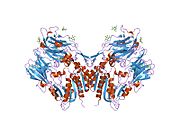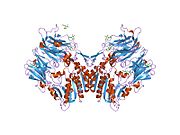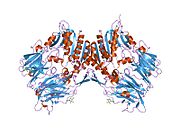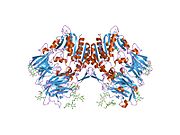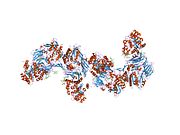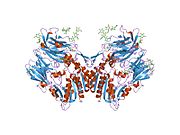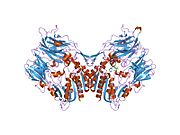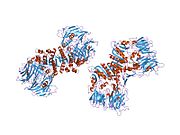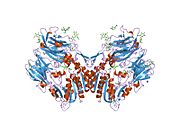Dipeptidyl peptidase-4
Dipeptidyl peptidase-4 (DPP4 or DPPIV), also known as adenosine deaminase complexing protein 2 or CD26 (cluster of differentiation 26) is a protein that, in humans, is encoded by the DPP4 gene. DPP4 is related to FAP, DPP8, and DPP9. The enzyme was discovered in 1966 by Hopsu-Havu and Glenner, and as a result of various studies on chemism, was called dipeptidyl peptidase IV [DP IV].
Function
The protein encoded by the DPP4 gene is an enzyme expressed on the surface of most cell types and is associated with immune regulation, signal transduction, and apoptosis. It is a type II transmembrane glycoprotein, but a soluble form, which lacks the intracellular and transmembrane part, is present in blood plasma and various body fluids. DPP-4 is a serine exopeptidase that cleaves X-proline or X-alanine dipeptides from the N-terminus of polypeptides. Peptide bonds involving the cyclic amino acid proline cannot be cleaved by the majority of proteases and an N-terminal X-proline "shields" various biopeptides. Extracellular proline-specific proteases therefore play an important role in the regulation of these biopeptides.
DPP-4 is known to cleave a broad range of substrates including growth factors, chemokines, neuropeptides, and vasoactive peptides. The cleaved substrates lose their biological activity in the majority of cases, but in the case of the chemokine RANTES and neuropeptide Y, DPP-4 mediated cleavage leads to a shift in the receptor subtype binding.
DPP4 plays a major role in glucose metabolism. It is responsible for the degradation of incretins such as GLP-1. Furthermore, it appears to work as a suppressor in the development of some tumors.
DPP-4 also binds the enzyme adenosine deaminase specifically and with high affinity. The significance of this interaction has yet to be established.
Animal studies
Animal studies suggest its pathogenetic role in development of fibrosis of various organs, such as liver and kidney.
Clinical significance
CD26/DPPIV plays an important role in tumor biology, and is useful as a marker for various cancers, with its levels either on the cell surface or in the serum increased in some neoplasms and decreased in others.
A class of oral hypoglycemics called dipeptidyl peptidase-4 inhibitors works by inhibiting the action of this enzyme, thereby prolonging incretin effect in vivo.
Middle East respiratory syndrome coronavirus has been found to bind to DPP4. It is found on the surface of cells in the airways (such as the lungs) and kidneys. Scientists may be able to use this to their advantage by blocking the virus's entry into the cell.
DPP4, or its Mycobacterial homologue MtDPP, might play a role in the pathogenesis of tuberculosis via cleavage of the chemokine C-X-C motif chemokine ligand 10 (CXCL10).
See also
Further reading
- Ansorge S, Bühling F, Kähne T, Lendeckel U, Reinhold D, Täger M, Wrenger S (1997). "CD26/Dipeptidyl Peptidase IV in Lymphocyte Growth Regulation". Cellular Peptidases in Immune Functions and Diseases. Advances in Experimental Medicine and Biology. 421. pp. 127–40. doi:10.1007/978-1-4757-9613-1_17. ISBN 978-1-4757-9615-5. PMID 9330689.
- Reinhold D, Kähne T, Steinbrecher A, Wrenger S, Neubert K, Ansorge S, Brocke S (2003). "The role of dipeptidyl peptidase IV (DP IV) enzymatic activity in T cell activation and autoimmunity". Biological Chemistry. 383 (7–8): 1133–8. doi:10.1515/BC.2002.123. PMID 12437097. S2CID 30027839.
- de Meester I, Lambeir AM, Proost P, Scharpé S (2003). "Dipeptidyl Peptidase IV Substrates". Dipeptidyl Aminopeptidases in Health and Disease. Advances in Experimental Medicine and Biology. 524. pp. 3–17. doi:10.1007/0-306-47920-6_1. ISBN 0-306-47717-3. PMID 12675218.
- Koch S, Anthonsen D, Skovbjerg H, Sjöström H (2003). "On the role of dipeptidyl peptidase IV in the digestion of an immunodominant epitope in celiac disease". Dipeptidyl Aminopeptidases in Health and Disease. Advances in Experimental Medicine and Biology. 524. pp. 181–7. doi:10.1007/0-306-47920-6_22. ISBN 0-306-47717-3. PMID 12675238.
- Pro B, Dang NH (October 2004). "CD26/dipeptidyl peptidase IV and its role in cancer". Histology and Histopathology. 19 (4): 1345–51. doi:10.14670/HH-19.1345. PMID 15375776.
External links
- The MEROPS online database for peptidases and their inhibitors: S09.003
- Dipeptidyl-Peptidase+IV at the U.S. National Library of Medicine Medical Subject Headings (MeSH)
- Banting and Best Diabetes Centre at UT dpp4
| この記事は、クリエイティブ・コモンズ・表示・継承ライセンス3.0のもとで公表されたウィキペディアの項目Dipeptidyl peptidase-4/en(8 March 2024編集記事参照)を素材として二次利用しています。 Lua error in Module:Itemnumber at line 91: attempt to concatenate local 'qid' (a nil value). |
